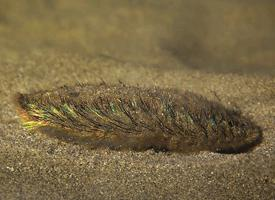
Poids et mesures
| Longueur | de 18 à 20 cm |
|---|
Description de l'animal
The Sea mouse, scientifically known as Aphrodita aculeata, is a fascinating and somewhat peculiar marine creature that captures the imagination of those who encounter it. Despite its common name, this creature is not a mouse at all but a type of polychaete worm, belonging to the class Polychaeta within the phylum Annelida. The name "Sea mouse" arises from its mouse-like appearance when viewed from above, with a rounded, furry-looking body that can deceive the casual observer. However, upon closer inspection, its true nature as a complex and intriguing marine organism becomes apparent.Aphrodita aculeata can be found in the North Atlantic Ocean, the North Sea, the Baltic Sea, and parts of the Mediterranean Sea, dwelling on the ocean floor at depths ranging from the shallow subtidal zones to several hundred meters deep. The habitat of the Sea mouse consists primarily of muddy or sandy substrates where it can burrow and scavenge for detritus and small organisms, making it an important part of the benthic ecosystem.
One of the most striking features of the Sea mouse is its dense covering of iridescent setae or bristles, which shimmer in a rainbow of colors due to the diffraction of light. These setae, which cover the sides and top of its body, serve multiple purposes, including protection from predators, aiding in locomotion, and facilitating respiration. The setae are also believed to play a role in the animal's sensory perception, helping it navigate through its dark, underwater world.
The body of the Sea mouse is elongated and somewhat flattened, measuring up to 30 centimeters (about 12 inches) in length, although sizes around 10 to 15 centimeters are more common. Its body is segmented, a characteristic feature of annelids, with each segment equipped with parapodia—paired appendages that aid in movement and gas exchange. The underside of the Sea mouse, which is less frequently seen, is softer and lacks the dense covering of setae found on the rest of its body.
Reproduction in Aphrodita aculeata is sexual, with individuals being either male or female. Spawning occurs throughout the year, with peaks in activity depending on the geographical location. Fertilization is external, with eggs and sperm being released into the water column where fertilization takes place. The larvae that emerge from the eggs are planktonic, drifting in the ocean currents until they are ready to settle on the ocean floor and metamorphose into the adult form.
The diet of the Sea mouse is primarily detritivorous, feeding on dead and decaying organic matter that settles on the seafloor. However, it is also known to prey on small invertebrates, which it captures using its eversible pharynx—a unique feeding adaptation among polychaetes.
Despite its somewhat unassuming name, the Sea mouse is a creature of remarkable beauty and complexity. Its iridescent bristles, intriguing morphology, and ecological role make it a fascinating subject of study for marine biologists and a captivating encounter for those lucky enough to observe it in its natural habitat.
Nouvelles photos d'animaux
Top 10 des animaux
- Dolphin gull (Leucophaeus scoresbii)
- Diana monkey (Cercopithecus diana)
- Moustached guenon (Cercopithecus cephus)
- Galápagos tortoise (Geochelone nigra complex)
- Russian tortoise (Testudo horsfieldii)
- Stone loach (Barbatula barbatula)
- Japanese macaque (Macaca fuscata)
- Greek tortoise (Testudo graeca)
- Common flying dragon (Draco volans)
- Vendace (Coregonus albula)